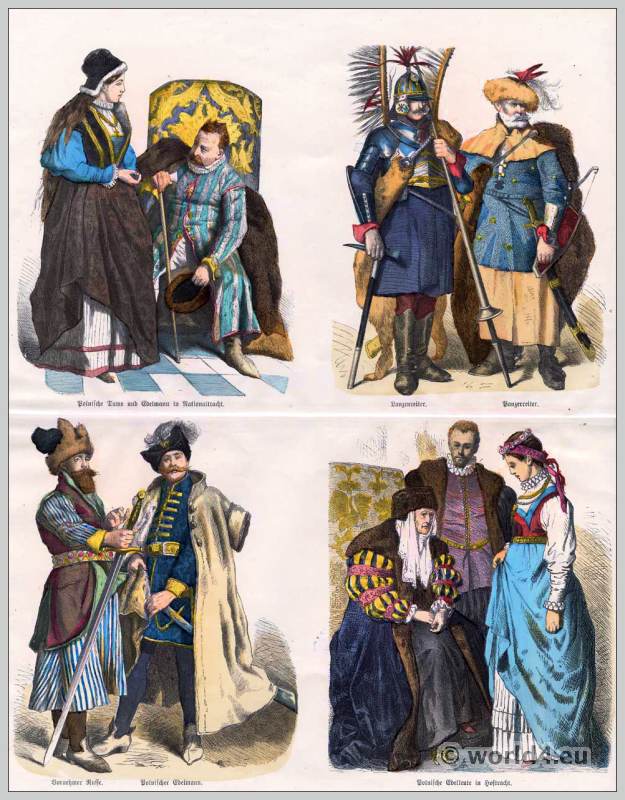
coisasdetere A Noiva… Rússia. Medieval Costume, Folk Costume, Costumes, Russian Beauty, Russian
BOOK Ancient Clothing & Folk Costumes in Eastern Europe | Russia Slavic pagan medieval fashion | jewelry archaeology history dress Ukraine (843) $ 50.00. Add to Favorites Linen Medieval dress with decorative hems and slit in a neckline; basic historical dress for Slavic and Viking reenactors (163) $ 178.89. FREE shipping.

kuntush Russian clothing, Medieval fashion, Fashion
Russian medieval armor, known for its intricate design and remarkable craftsmanship, holds a significant place in the history of warfare. From the iconic suits of armor worn by knights to the unique helmets and shields adorned with elaborate engravings, these pieces not only provided protection but also reflected the artistic sensibilities of their creators.

Polish and Russian costumes 16th century.
The traditional Russian costume used to be a part of the country's history up until the beginning of the eighteenth century, when Peter the Great proclaimed the Russian dress to be 'peasant and non progressive'. He introduced a law that fined anyone who entered the city in traditional national clothes, as well as anyone with a beard.The citizens, aristocracy, merchants and other.

Russian Beauty, Russian Fashion, Medieval Costume, Folk Costume, Scandinavian Dress, Skier, Folk
Medieval Russian fashion was heavily influenced by the Byzantine and Mongol Empires, featuring long, flowing garments, rich embroidery, intricate headpieces, vibrant colors symbolizing wealth and power, luxurious fabrics like silk and velvet, and ornate accessories such as fur hats and beaded jewelry; it differed from European styles of the time.

Pin by Alice Sheeler on Women Beauty Ideas Medieval princess, Russian princess, Medieval fashion
Among 10th-century medieval Russian burials, the most detailed information about remnants of clothing can be obtained from inhumed burials. Among these, the richest and most diverse inventory comes from burials performed using wooden burial chambers. [3] Lebedev, G.S. "Sotsial'naja topografija mogil'nika epokhi vikingov v Birke."Skandinavskij sbornik.

Traditional costumes of boyars, Russian medieval aristocrats. 16th century, modern replica.In
Medieval and Early Modern Russia and Ukraine. at the University of Washington (Seattle) Life in 13th Century Novgorod by Gregory William Frux. Birka Traders Viking, Byzantine and Rus goods from Australia. Miklagard - an impressive group of reeneactors from the New Varangian Guard. Christobel's and Peter's page.

1769 best Russian Clothing Inspiration Medieval and Otherwise images on Pinterest Russian
Researchers of medieval Russian clothing have long since turned their attention to the fact that clothing of the pre-Mongol period was trimmed with various forms of ribbon (Prokhorov, V.A., 1881, pp. 67, 76-77; Rzhiga, V.F., 1932, p. 54). Among the archeological samples of fabric in the State Historical Museum, a large quantity is composed of.

Pin by Nunya on Inspiration Russian clothing, Medieval clothing, Medieval fashion
An unexpected rabbit-hole. If you asked me a year ago what I would do for Athenaeum this year, I would have told you I was going to build on last year's project (his-and-hers Italian and French garb for the year 1385).I barely had enough time to get the clothing assembled and ready to wear, but I didn't get to the fancy bits: embroidery, applique, trim….

Pin on Stuff I like
The fashion trends that held sway over Russian dress were diverse and many, resulting in a rich history of traditional Russian clothing. Historical Background. During the medieval era in Western Europe, Eastern Europe was a series of isolated territories in which power and control changed hands often. Russia was one of these terrritories.

Russian Traditional Clothing for women Историческая платье, Быть женщиной, Традиционные платья
The Armorial Hall of the Winter Palace (detail). A. Ladurner (1834) Russian court dress was a special regulated style of clothing that aristocrats and courtiers at the Russian imperial court in the 19th-20th centuries had to follow. Clothing regulations for courtiers and those invited to the court are typical for most European monarchies, from the 17th century to the present.

Pin on Medieval Russian Clothing
Browse 973 medieval russian clothing photos and images available, or start a new search to explore more photos and images. Browse Getty Images' premium collection of high-quality, authentic Medieval Russian Clothing stock photos, royalty-free images, and pictures.

Новости Этнические наряды, Костюм, Исторические костюмы
RUSSIA: HISTORY OF DRESSThe systematic study of the history of dress in Russia began in 1832 with the publication of a book by the president of the Academy of Arts, Aleksei Nikolaevich Olenin (1763-1843). The occasion for the writing of this book was a decree of the Emperor Nicholas I, who expressed the desire to see a painting with many figures on the theme of the most important event in.

_YYTZL7t9uk.jpg (723×1280) Russian clothing, Medieval fashion, Historical dresses
Browse 8,800+ medieval russian clothing stock photos and images available, or start a new search to explore more stock photos and images. Young man as Nicholas II on dark green background. Retro style,. Thoughtful. Young man in suit as Nicholas II isolated on dark green background.

Moscovite era Historical Costume, Historical Clothing, Traditional Fashion, Traditional Dresses
Fun Videos about Late Medieval Russian Clothing. I recently came across these videos posted on YouTube by the Museums of the Moscow Kremlin, talking about late-medieval (16th-17th….

Pin by Casey on Scadian Fashion, Russian fashion, Medieval fashion
In medieval Russia, traditional men's clothing was largely the same throughout the country. It typically included pants, a shirt, a hat, and a belt. While women had the ability to embellish their everyday attire, men's traditional clothing was known for its simplicity.

Russian costumes. Tsar, Boyar, Belorussian garb. Costume History
The scarf or traditional headdress was a mandatory element of the peasant outfit. On display are outfits originating from several distinct areas in northern, southern and central Russia. Russian traditional dress began to develop as a specific form in the 9th century. Until the early 18th century, peasants and boyars (noblemen) wore traditional.